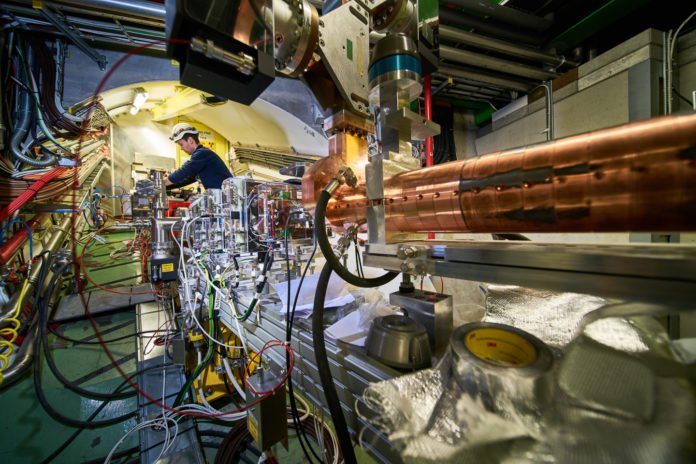For the first ever time, scientists have demonstrated a way to accelerate electrons using protons passing through the plasma. Scientists made this important discovery using a factor of around 100 over a length of 10 meters: they were externally injected into AWAKE at an energy of around 19 MeV (million electron volts) and attained an energy of almost 2 GeV (billion electron volts).
Installing a Large Hadron Collider (LHC) particle accelerator require a concrete tunnel about 27 kilometers (nearly 17 miles) long and US$5 billion in spare change. But this new experiment uses something known as plasma wakefield acceleration – and it takes up just 10 meters or 33 feet of space.
Scientists noted that the discovery could drastically reduce the sizes, and therefore the costs, of the accelerators needed to achieve the high-energy collisions.
The team behind the Advanced Proton Driven Plasma Wakefield Acceleration Experiment (AWAKE) at CERN in Geneva has been working since 5 years after CERN approved the project in 2013. Although it’s still in early stages, scientists predicted that this could end up driving a huge improvement in the way we examine the fundamental physics of the world.
Traditional accelerators use what are known as radio-frequency (RF) cavities to kick the particle beams to higher energies. This involves alternating the electrical polarity of positively and negatively charged zones within the RF cavity, with the combination of attraction and repulsion accelerating the particles within the cavity. By contrast, in wakefield accelerators, the particles get accelerated by “surfing” on top of the plasma wave (or Wakefield) that contains similar zones of positive and negative charges.
Allen Caldwell, spokesperson of the AWAKE collaboration said, “Wakefield accelerators have two different beams: the beam of particles that is the target for the acceleration is known as a ‘witness beam’, while the beam that generates the Wakefield itself is known as the ‘drive beam’.”
“AWAKE is the first experiment to use protons for the drive beam, and CERN provides the perfect opportunity to try the concept. Drive beams of protons penetrate deeper into the plasma than drive beams of electrons and lasers. Therefore, Wakefield accelerators relying on protons for their drive beams can accelerate their witness beams for a greater distance, consequently allowing them to attain higher energies.”
In the new technique, a beam of protons fired through super-hot plasma acts a bit like a boat kicking up waves – these bubbles of intense electrical fields that get created are what’s called the Wakefield.
If a beam of electrons is then sent through the same container and timed to synchronize with the electrical fields perfectly, the electrons can ride these waves like surfers, achieving high speeds in a short distance.
Matthew Wing from University College London in the UK said, “For all this to work, drive protons need to be obtained from the Super Proton Synchrotron (SPS) at CERN – a 7-kilometer (4.3-mile) tube which also supplies the LHC with protons. With that in mind, we’re not quite at the stage where we can fit a particle accelerator into a cupboard – but the signs are good.”
“Over the space of 10 meters (33 feet), electrons were accelerated to 2 GeV (giga-electron volts). That’s much less than existing electron accelerators, which can produce 6 GeV and way beyond that – the current record is 13 TeV, or 13,000 GeV, which is held by the Large Hadron Collider.”
Patric Muggli, physics coordinator for AWAKE said, “Now we have demonstrated the ability to accelerate electrons using a proton-driven plasma Wakefield, the AWAKE team is looking to the future. Our next steps include plans for delivering accelerated electrons to a physics experiment and extending the project with a full-fledged physics programme of its own.”
The study is originally published in the journal Nature.
